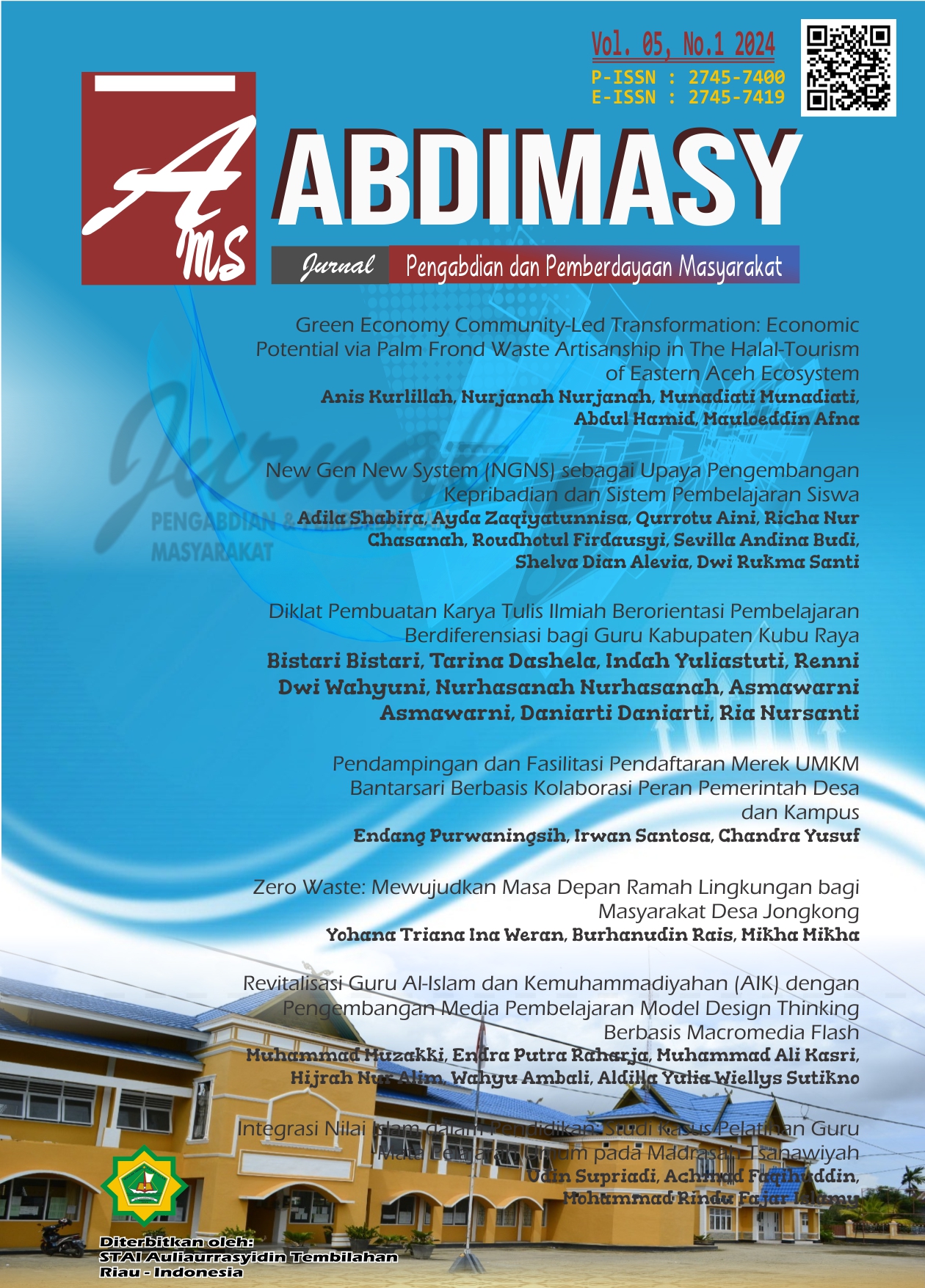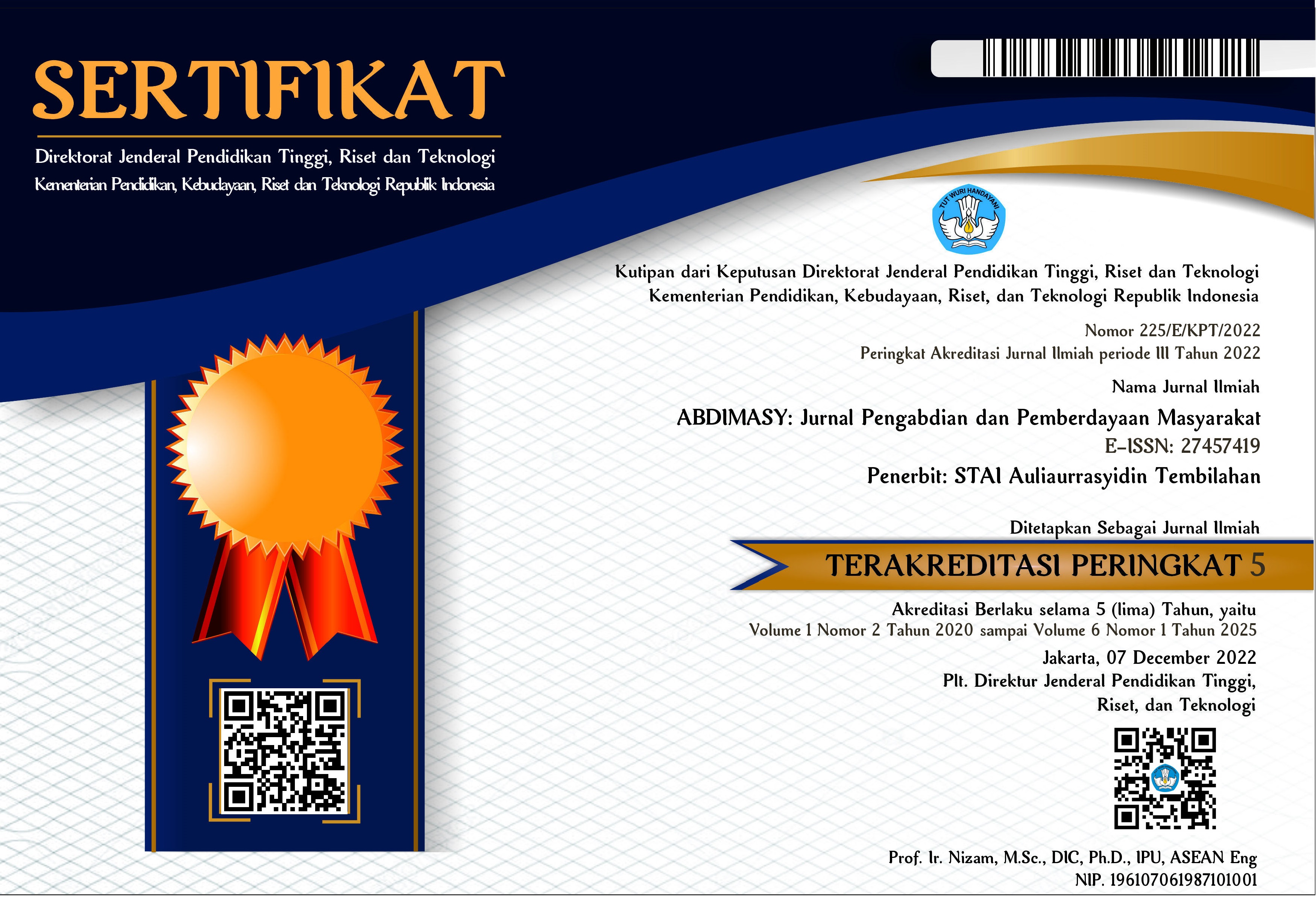Diklat Pembuatan Karya Tulis Ilmiah Berorientasi Pembelajaran Berdiferensiasi bagi Guru Kabupaten Kubu Raya
DOI:
https://doi.org/10.46963/ams.v5i1.1782Keywords:
Education and training, Differentiation Learning, Scientific papersAbstract
This training adapts to the needs of teachers in the independent curriculum. The Education Office in collaboration with FKIP Tanjungpura University trained 70 teachers in Kubu Raya district, focusing on differentiated learning. Participants were reinforced on the characteristics and types of differentiated learning: proactive, emphasizing quality, rooted in assessment, and providing multiple approaches. They are directed to choose or combine differentiated learning types (content, process, product) and link them to research such as PTK, best practice, or descriptive papers. Participants submit a draft paper with title and background for the resource person to comment on. Implementation in schools is monitored via WhatsApp by the Kesuma Bangsa Journal team. The purpose of implementation is as a real action for driving teachers and article material for journals. The activity was closed with a post-test to assess the increase in understanding, which increased from 45.07 to 56.07 points. The training went smoothly and according to plan.
Downloads
References
Amaliyah. (2019). Program kemitraan masyarakat: Peningkatan kemampuan penulisan karya ilmiah dan teknik publikasi di jurnal internasional. Intervensi Komunitas, 1(1), 48–56.
Batista, G. (2006). “Scientific Publication.” Ambiente e Agua – An Interdisciplinary. Journal of Applied Science, 1(2), 11–14. https://doi.org/10.4136/AMBI-AGUA.8
Dangal, G., P. K. Hamal, dan M. G. (2017). “Understanding Research and Scientific Publication.” Journal of Nepal Health Research Council, 15(35), I–II. https://doi.org/10.3126/JNHRC.V15I1.18005
Djuroto, T., dan Supriyadi, B. (2007). Menulis Artikel dan Karya Ilmiah. Bandung: Remaja Rosda Karya.
Dwipayana, A. (2003). Karya Ilmiah Menulis di Media. Jakarta: Global Mahardika.
Franco, J. (2020). “Introducing the Analysis of Journal Articles.” https://doi.org/doi: 10.33774/APSA- 2020-VHJSV.
Ismail & Elihami. (2019). Pelatihan penyusunan artikel publikasi ilmiah bagi mahasiswa perguruan tinggi STKIP Muhammadiyah Enrekang. Maspul Journal of Community Empowerment, 1(1), 12–20. https://doi.org/https://doi.org/10.33487/
Lukman, SS Ahmadi, W. Manalu, dan D. H. (2019). PEDOMAN PUBLIKASI ILMIAH 2019.
Marselina, S. (2018). Peningkatan keterampilan menulis karya ilmiah melalui strategi belajar kooperatif tipe group investigation siswa kelas XI MAN I Kota Sungai Penuh. Jurnal Ilmiah Pendidikan Bahasa Dan Sastra Indonesia, 4(1), 14–21. http://www.antaranews.com/berita/330125/lipi-
Ming, K. E. (2006). “How To Write A Journal Article?” In Malaysian Family Physician : The Official Journal of the Academy of Family Physicians of Malaysia (Vol. 1, Issues 2–3).
Nurudin. (2007). Dasar-dasar Penulisan. Malang: UMM Press.
Pathuddin, P., Linawati, L., & Hamid, A. (2018). PKM pelatihan dan workshop penyusunan dan publikasi karya ilmiah untuk meningkatkan kemampuan profesionalisme guru SD di Kecamatan Banawa Selatan. JATI EMAS (Jurnal Aplikasi Teknik Dan Pengabdian Masyarakat), 2(2), 78. https://doi.org/https://doi.org/10.36339/je.v2i2.157
Rusdiana, A. (2019). Panduan Penulisan Artikel Jurnal Ilmiah.
Slameto, S. (2016). Penulisan artikel ilmiah hasil penelitian tindakan kelas. Scholaria : Jurnal Pendidikan Dan Kebudayaan, 6(2), 46. https://doi.org/https://doi.org/10.24246/j.scholaria.2016.v6.i2.p46-57
Suroso. (2008). Menulis artikel untuk jurnal ilmiah terakreditasi. Diskusi Ilmiah Menuju Penerbitan Publikasi Ilmiah Terakreditasi BPN STPN. Desember, 1–17.
Willinsky, J. (2005). Open Journal Systems: An Example of Open Source Software for Journal Management and Publishing. Library Hi Tech, 23(4), 504–519. https://doi.org/10.1108/07378830510636300
Downloads
Published
Issue
Section
License
Copyright (c) 2024 Bistari Bistari, Tarina Dashela, Indah Yuliastuti, Renni Dwi Wahyuni, Nurhasanah Nurhasanah, Asmawarni Asmawarni, Daniarti Daniarti, Ria Nursanti

This work is licensed under a Creative Commons Attribution-ShareAlike 4.0 International License.
Authors who publish with this journal agree to the following terms:
1. Copyright on any article is retained by the author(s).
2. The author grants the journal, right of first publication with the work simultaneously licensed under a Creative Commons Attribution shareAlike 4.0 International License that allows others to share the work with an acknowledgment of the work’s authorship and initial publication in this journal.
3. Authors are able to enter into separate, additional contractual arrangements for the non-exclusive distribution of the journal’s published version of the work (e.g., post it to an institutional repository or publish it in a book), with an acknowledgment of its initial publication in this journal.
4. Authors are permitted and encouraged to post their work online (e.g., in institutional repositories or on their website) prior to and during the submission process, as it can lead to productive exchanges, as well as earlier and greater citation of published work.
5. The article and any associated published material is distributed under the Creative Commons Attribution-ShareAlike 4.0 International License





2.png)



